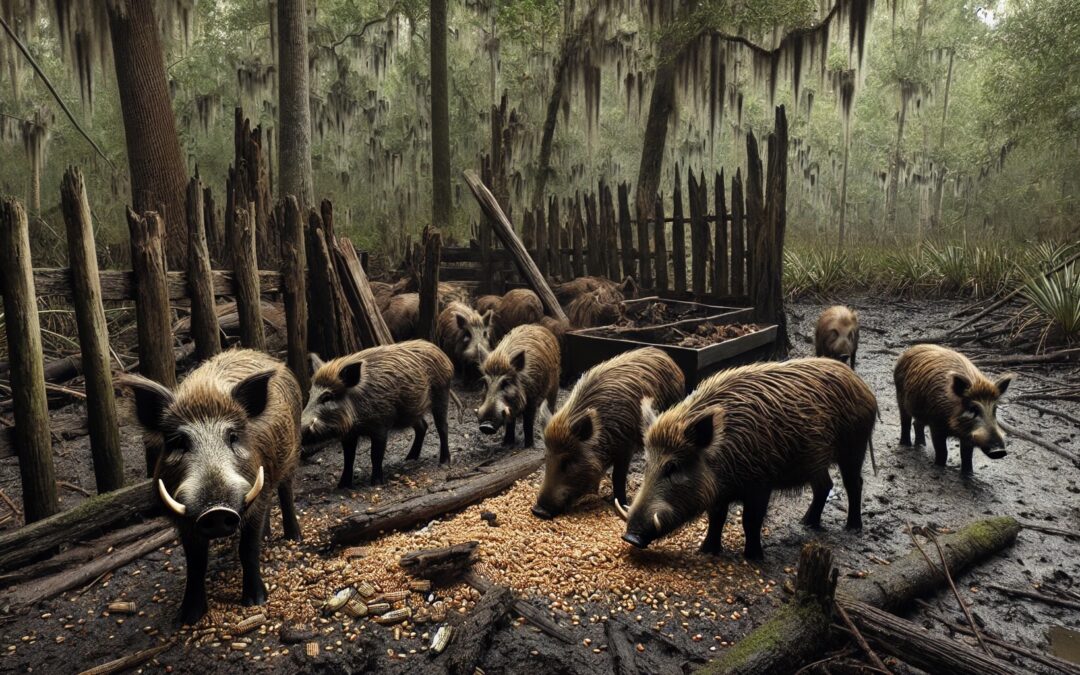Some years ago, about maybe 1900, an old trapper from North Dakota hitched up some horses to his Studebaker wagon, packed a few possessions—especially his traps—and drove south.
Several weeks later he stopped in a small town just north of the Okefenokee Swamp in Georgia. It was a Saturday morning—a lazy day—when he walked into the general store. Sitting around the pot-bellied stove were seven or eight of the town’s citizens.
The traveler spoke. “Gentlemen, could you direct me to the Okefenokee Swamp?” Some of the old-timers looked at him like he was crazy. “You must be a stranger in these parts,” they said. “I am. I’m from North Dakota,” said the stranger.
“In the Okefenokee Swamp are thousands of wild hogs.” one old man explained. “A man who goes into the swamp by himself asks to die!” He lifted up his leg. “I lost half my leg here to the pigs of the swamp.” Another old fellow said, “Look at the cuts on me; look at my arm bit off! Those pigs have been free since the Revolution, eating snakes and rooting out roots and fending for themselves for over a hundred years. They’re wild and they’re dangerous. You can’t trap them. No man dare go into the swamp by himself.” Every man nodded his head in agreement.
The old trapper said, “Thank you so much for the warning. Now could you direct me to the swamp?” They said, “Well, yeah, it’s due south — straight down the road.” But they begged the stranger not to go, because they knew he’d meet a terrible fate. He said, “Sell me ten sacks of corn, and help me load it in the wagon.” And they did. Then the old trapper bid them farewell and drove on down the road. The townsfolk thought they’d never see him again.
Two weeks later the man came back. He pulled up to the general store, got down off the wagon, walked in and bought ten more sacks of corn. After loading it up he went back down the road toward the swamp.
Two weeks later he returned and again bought ten sacks of corn. This went on for a month. And then two months, and three. Every week or two the old trapper would come into town on a Saturday morning, load up ten sacks of corn, and drive off south into the swamp.
The stranger soon became a legend in the little village and the subject of much speculation. People wondered what kind of devil had possessed this man, that he could go into the Okefenokee by himself and not be consumed by the wild and free hogs.
One morning the man came into town as usual. Everyone thought he wanted more corn. He got off the wagon and went into the store where the usual group of men was gathered around the stove. He took off his gloves. “Gentlemen,” he said, “I need to hire about ten or fifteen wagons. I need twenty or thirty men. I have six thousand hogs out in the swamp, penned up, and they’re all hungry. I’ve got to get them to market right away.”
“You have WHAT in the swamp?” asked the storekeeper, incredulously. “I have six thousand hogs penned up. They haven’t eaten for two or three days, and they’ll starve if I don’t get back there to feed and take care of them.”
One of the old-timers said, “You mean you’ve captured the wild hogs of the Okefenokee?” “That’s right.” “How did you do that? What did you do?” the men urged, breathlessly. One of them exclaimed, “But I lost my arm!” “I lost my brother!” cried another. “I lost my leg to those wild boars!” chimed a third.
The trapper said, “Well, the first week I went in there they were wild all right. They hid in the undergrowth and wouldn’t come out. I dared not get off the wagon. So I spread corn along behind the wagon. Every day I’d spread a sack of corn. The old pigs would have nothing to do with it.”
“But the younger pigs decided that it was easier to eat free corn than it was to root out roots and catch snakes. So the very young began to eat the corn first. I did this every day. Pretty soon, even the old pigs decided that it was easier to eat free corn. After all, they were all free; they were not penned up. They could run off in any direction they wanted at any time.”
“The next thing was to get them used to eating in the same place all the time. So I selected a clearing, and I started putting the corn in the clearing. At first they wouldn’t come to the clearing. It was too far. It was too open. It was a nuisance to them.”
“But the very young decided that it was easier to take the corn in the clearing than it was to root out roots and catch their own snakes. And not long after, the older pigs also decided that it was easier to come to the clearing every day.”
“And so the pigs learned to come to the clearing every day to get their free corn. They could still subsidize their diet with roots and snakes and whatever else they wanted. After all, they were all free. They could run in any direction at any time. There were no bounds upon them.”
“The next step was to get them used to fence posts. So I put fence posts all the way around the clearing. I put them in the underbrush so that they wouldn’t get suspicious or upset. After all, they were just sticks sticking up out of the ground, like the trees and the brush. The corn was there every day. It was easy to walk in between the posts, get the corn, and walk back out.”
“This went on for a week or two. Shortly they became very used to walking into the clearing, getting the free corn, and walking back out through the fence posts.”
“The next step was to put one rail down at the bottom. I also left a few openings so that the older, fatter pigs could walk through the openings and the younger pigs could easily jump over just one rail. After all, it was no real threat to their freedom or independence. They could always jump over the rail and flee in any direction at any time.”
“Now I decided that I wouldn’t feed them every day. I began to feed them every other day. On the days I didn’t feed them the pigs still gathered in the clearing. They squealed, and they grunted, and they begged and pleaded with me to feed them. But I only fed them every other day. And I put a second rail around the posts.”
“Now the pigs became more and more desperate for food. Because now they were no longer used to going out and digging their own roots and finding their own food. They now needed me. They needed my corn every other day. So I trained them that I would feed them every day if they came in through a gate. And I put up a third rail around the fence. But it was still no great threat to their freedom, because there were several gates and they could run in and out at will.”
“Finally I put up the fourth rail. Then I closed all the gates but one, and I fed them very, very well. Yesterday I closed the last gate. And today I need you to help me take these pigs to market.”

